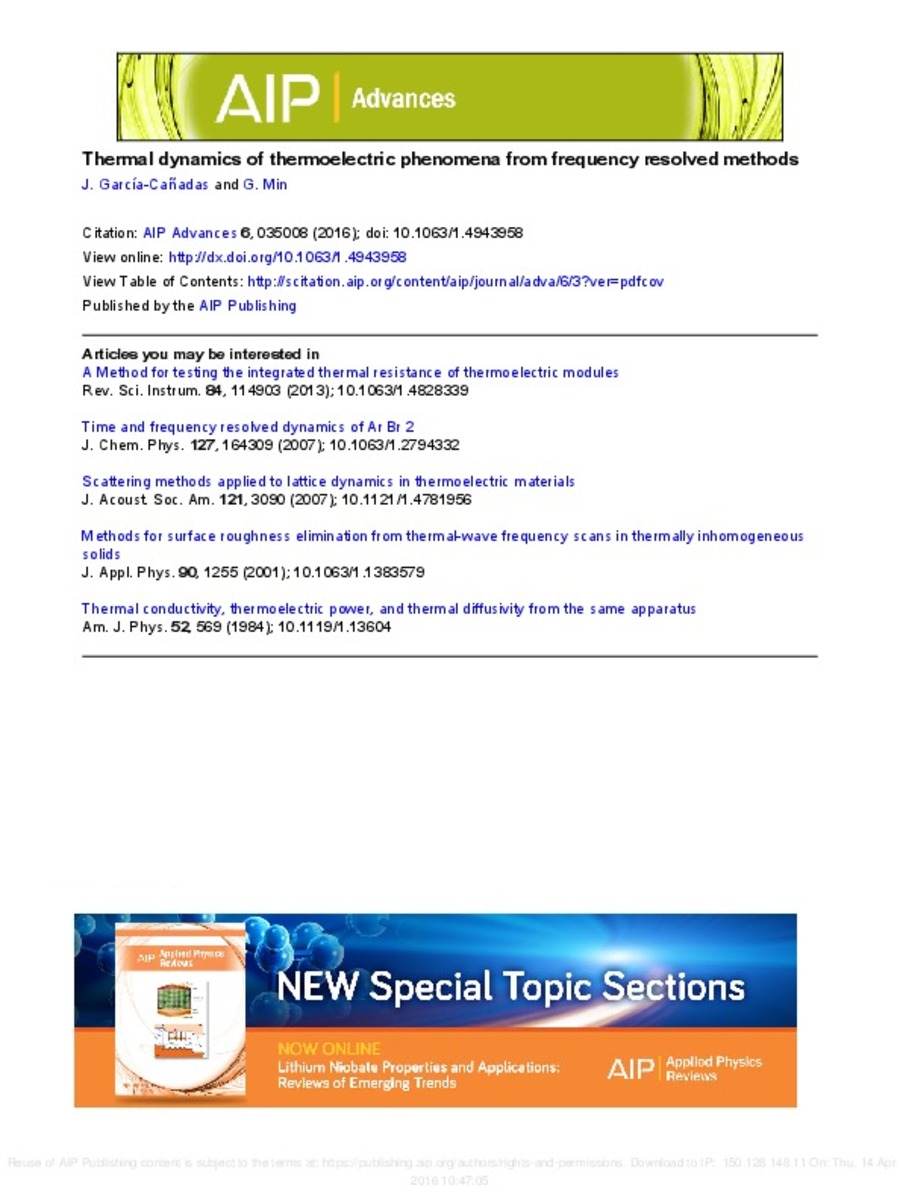Mostrar el registro sencillo del ítem
Thermal dynamics of thermoelectric phenomena from frequency resolved methods
| dc.contributor.author | García-Cañadas, Jorge | |
| dc.contributor.author | Min, Gao | |
| dc.date.accessioned | 2016-04-14T11:10:07Z | |
| dc.date.available | 2016-04-14T11:10:07Z | |
| dc.date.issued | 2016-03-09 | |
| dc.identifier.citation | GARCÍA-CAÑADAS, J.; MIN, G. Thermal dynamics of thermoelectric phenomena from frequency resolved methods. AIP Advances, 2016, vol. 6, no 3, p. 035008. | ca_CA |
| dc.identifier.issn | 2158-3226 | |
| dc.identifier.uri | http://hdl.handle.net/10234/158625 | |
| dc.description.abstract | Understanding the dynamics of thermoelectric (TE) phenomena is important for the detailed knowledge of the operation of TE materials and devices. By analyzing the impedance response of both a single TE element and a TE device under suspended conditions, we provide new insights into the thermal dynamics of these systems. The analysis is performed employing parameters such as the thermal penetration depth, the characteristic thermal diffusion frequency and the thermal diffusion time. It is shown that in both systems the dynamics of the thermoelectric response is governed by how the Peltier heat production/absorption at the junctions evolves. In a single thermoelement, at high frequencies the thermal waves diffuse semi-infinitely from the junctions towards the half-length. When the frequency is reduced, the thermal waves can penetrate further and eventually reach the half-length where they start to cancel each other and further penetration is blocked. In the case of a TE module, semi-infinite thermal diffusion along the thickness of the ceramic layers occurs at the highest frequencies. As the frequency is decreased, heat storage in the ceramics becomes dominant and starts to compete with the diffusion of the thermal waves towards the half-length of the thermoelements. Finally, the cancellation of the waves occurs at the lowest frequencies. It is demonstrated that the analysis is able to identify and separate the different physical processes and to provide a detailed understanding of the dynamics of different thermoelectric effects. | ca_CA |
| dc.description.sponsorShip | The authors wish to acknowledge financial support from the Accelerated Metallurgy Project, which was co-funded by the European Commission in the 7th Framework Programme (Contract No. NMP4-LA-2011-263206), by the European Space Agency and by the individual partner organizations. | ca_CA |
| dc.format.extent | 10 p. | ca_CA |
| dc.format.mimetype | application/pdf | ca_CA |
| dc.language.iso | eng | ca_CA |
| dc.publisher | American Institute of Physics (AIP) | ca_CA |
| dc.relation.isPartOf | AIP Advances, 2016, vol. 6, no 3 | ca_CA |
| dc.rights | © 2016 Author(s). All article content, except where otherwise noted, is licensed under a Creative Commons Attribution (CC BY) license (http://creativecommons.org/licenses/by/4.0/). | ca_CA |
| dc.rights.uri | http://rightsstatements.org/vocab/InC/1.0/ | * |
| dc.subject | Ceramic materials | ca_CA |
| dc.subject | Diffusion | ca_CA |
| dc.subject | Heat storage | ca_CA |
| dc.subject | Thermal diffusion | ca_CA |
| dc.subject | Thermoelectricity | ca_CA |
| dc.subject | Heat production | ca_CA |
| dc.subject | High frequency HF | ca_CA |
| dc.subject | Impedance response | ca_CA |
| dc.subject | Physical process | ca_CA |
| dc.subject | Thermal dynamics | ca_CA |
| dc.subject | Thermal penetration depths | ca_CA |
| dc.subject | Thermoelectric | ca_CA |
| dc.subject | Thermoelectric response | ca_CA |
| dc.title | Thermal dynamics of thermoelectric phenomena from frequency resolved methods | ca_CA |
| dc.type | info:eu-repo/semantics/article | ca_CA |
| dc.identifier.doi | http://dx.doi.org/10.1063/1.4943958 | |
| dc.rights.accessRights | info:eu-repo/semantics/openAccess | ca_CA |
| dc.relation.publisherVersion | http://scitation.aip.org/content/aip/journal/adva/6/3/10.1063/1.4943958 | ca_CA |
Ficheros en el ítem
Este ítem aparece en la(s) siguiente(s) colección(ones)
-
ESID_Articles [465]







